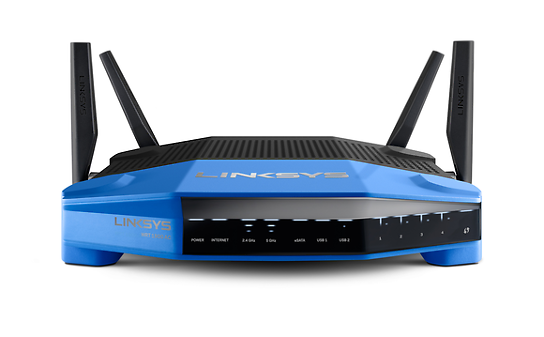New, Linksys Open Source Based Router!
 I love this! Open Source based right out of the box!
I love this! Open Source based right out of the box!
Linksys announces the audacious-looking WRT1900AC Dual Band Wi-Fi router
PCWorld – Michael Brown – LAS VEGAS – “The engineers at Linksys jumped into the way-back machine to design the new WRT1900AC Dual Band Wi-Fi Router. While the stackable enclosure sports the classic blue/black color scheme of the classic WRT54G 802.11g router, you’ll find all-new hardware inside, including a dual-core 1.2GHz ARM processor, 128MB of flash memory, and 256MB of DDR3 RAM.
The new router looks like a beast—it weighs in at a staggering 5 pounds—and it sports a feature set that owners of the the WRT54G could never have imagined, including one USB 3.0 port; one eSATA/USB 2.0 combo port; support for just about any hard drive format, including FAT, NTFS, and HFS+; and four external, removable antennas. It will have a four-port gigabit switch and a gigabit WAN port. The router will be capable of sharing both USB storage and a USB printer over the network.
Four antennas; three spatial streams
There will be immediate comparisons to Asus’s unannounced (officially, at least) RT-AC87U, the existence of which was revealed in a press release from 802.11ac chipset manufacturer Quantenna. One of the key differences is that the Quantenna chipset delivers four spatial streams and can provide a physical link rate of 1.7 Gbps. To take advantage of that speed, of course, you’ll need a client adapter that can also support four spatial streams, and I haven’t heard of any such animal.
Either way, the Marvell chipset Linksys chose for the WRT1900AC is limited to three spatial streams and a physical link rate of 1.3Gbps on the 5GHz frequency band using the 802.11ac protocol. The router will support throughput of 600 mbps on the 2.4GHz frequency band using the 802.11n protocol.
In a pre-CES briefing, Linksys VP of product management Mike Chen told me that the WRT1900AC will use all four antennas to determine the best combination, and it will then turn off whichever single antenna delivers the least throughput. Chen said they’ve seen TCP throughput of 900 mbps in their lab tests, when the router and a client connected to a second router configured as a wireless bridge are in relatively close proximity. Chen also said the WRT1900AC delivered 30 percent better range than their current best 802.11ac router, the EA6900.
It was the WRT54G that got the open-source community producing open firmware in earnest—with projects such as DD-WRT—and Chen said Linksys will have an Open WRT SDK (software-development kit) ready when the new router ships later this spring. Linksys is also working on various peripheral devices that can be stacked beneath the WRT1900AC (not on top, lest the router overheat). The company might also offer optional antennas.”